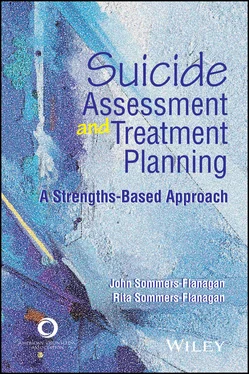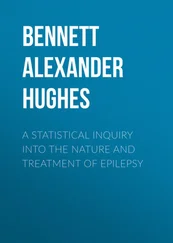John Sommers-Flanagan - Suicide Assessment and Treatment Planning
Здесь есть возможность читать онлайн «John Sommers-Flanagan - Suicide Assessment and Treatment Planning» — ознакомительный отрывок электронной книги совершенно бесплатно, а после прочтения отрывка купить полную версию. В некоторых случаях можно слушать аудио, скачать через торрент в формате fb2 и присутствует краткое содержание. Жанр: unrecognised, на английском языке. Описание произведения, (предисловие) а так же отзывы посетителей доступны на портале библиотеки ЛибКат.
- Название:Suicide Assessment and Treatment Planning
- Автор:
- Жанр:
- Год:неизвестен
- ISBN:нет данных
- Рейтинг книги:4 / 5. Голосов: 1
-
Избранное:Добавить в избранное
- Отзывы:
-
Ваша оценка:
- 80
- 1
- 2
- 3
- 4
- 5
Suicide Assessment and Treatment Planning: краткое содержание, описание и аннотация
Предлагаем к чтению аннотацию, описание, краткое содержание или предисловие (зависит от того, что написал сам автор книги «Suicide Assessment and Treatment Planning»). Если вы не нашли необходимую информацию о книге — напишите в комментариях, мы постараемся отыскать её.
Suicide Assessment and Treatment Planning — читать онлайн ознакомительный отрывок
Ниже представлен текст книги, разбитый по страницам. Система сохранения места последней прочитанной страницы, позволяет с удобством читать онлайн бесплатно книгу «Suicide Assessment and Treatment Planning», без необходимости каждый раз заново искать на чём Вы остановились. Поставьте закладку, и сможете в любой момент перейти на страницу, на которой закончили чтение.
Интервал:
Закладка:
If you are employed by an agency or school, you will need to know its suicide policy. When you join a new agency or school, read the institution’s suicide-related policies and procedures and discuss them with a senior clinician or administrative staff before you even begin seeing clients or students. If your agency or school does not have suicide-related policies and procedures, work with your administration to adopt a temporary working model from a similar agency, and establish a task force to create a more permanent model. You never know when the next client or student will be suicidal. On the first week of his first job, one of our graduates had to manage a student who was actively suicidal. He called and said, “Wow! You guys weren’t kidding when you said to know how to handle things before you even open the door!” (see Wheeler & Bertram, 2019, for more information on legal issues in counseling).
Competency 10: Engage in Debriefing and Self-Care
Feeling responsible for life-and-death situations is overwhelming (Cramer et al., 2013). As in the opening case of Kevin, when clients make suicide attempts or die by suicide, practitioners often experience an avalanche of guilt, preoccupation with possible mistakes, and feelings of incompetence. Even though such feelings are natural, they are still extremely difficult. As noted in Chapter 1, self-care is always important for mental health and school professionals, but when suicide is the issue, self-care is especially critical (Binkley & Leibert, 2015).
Debriefings of some sort are important whenever you conduct a suicide assessment. Debriefings may involve you taking the lead and reporting exactly how you handled a particular assessment or intervention. They can also include your supervisor (or classmates or colleagues) asking specific questions. Common debriefing questions include the following:
1 What clinical observations increased your concerns about suicide?
2 What clinical observations decreased your concerns about suicide?
3 What risk and protective factors did you notice through observation? What risk and protective factors did you ask about?
4 How did you directly ask your client about suicide? What was your client’s response?
5 What was the quality of your therapeutic relationship or connection?
6 Did you trust that what your client told you was truthful? If so, what made you trust your client? If not, what made you reluctant to trust your client?
7 Did you gather information about the frequency, intensity, duration, and termination of your client’s suicidal ideation? What was your client’s response to these questions?
8 Did you ask about previous attempts? What was your client’s response?
9 Did you ask about suicide plans? What was your client’s response?
10 What were your client’s reasons for living and reasons for dying?
11 Did you initiate a safety planning intervention? If so, what was your client’s response?
12 What was your impression regarding your client’s willingness to engage in ongoing counseling?
Suicide-Related Ethical Issues
Imagine you are working as a school professional. Three high school students suddenly pop into your office. They take turns speaking, saying things like the following:
“Serena is talking about suicide.”
“She posted a creepy thing about death on Instagram that’s freaking us out.”
“We think you should talk with her.”
“She’s been drinking way too much. We’re totally scared.”
This case scenario highlights the complexities associated with decision-making around suicidality. Many questions arise. Should you summon Serena from class and meet with her? Serena is 16 years old; does that mean you have a responsibility to contact her parents? What is the school district’s policy on suicide risk assessment? If Serena admits to suicidal ideation but assures you she will not act on her thoughts, what discretion do you have as to whether or not you contact her parents? If Serena denies suicidal ideation and says her friends are being silly and stupid, do you have any duty to protect? At a minimum, cases like Serena’s reveal the importance of knowing your school’s (or agency’s) suicide assessment and disposition protocol (including whom to contact first). Here we cover ethical considerations specific to suicidality and related emergent or dangerous clinical concerns.
Is Serena Suicidal?
School counselors and school mental health professionals gain information about students in many different ways. In an ideal world, Serena would approach you, acknowledge suicidal ideation, and ask for help; you would responsibly follow your district’s policy for informing your school administrator, contacting the parents, providing referral information, and staying in touch with Serena via your school’s suicide-related case management protocol. Unfortunately, the opposite process may unfold. You may hear about Serena’s suicidality through her friends or via a teacher. Serena may never approach you and may not be honest with you about her suicidal ideation. To complicate matters further, your district policy may be enigmatic or excessively detailed, Serena’s parents may be unreachable or overreactive, referral resources may be nonexistent, and you may not have a case management protocol for students who are suicidal.
In an article in the American School Counselor Association’s magazine ( ASCA School Counselor ), Carolyn Stone (2018) described school counselors’ responsibilities for reporting suicidal ideation. Her article included the following points:
1 If you learn that a student is thinking about suicide, contact the parents or other appropriate adults: “Regardless of whether or not we have a state statute to guide our behavior, we must make certain everyone in our profession understands calling parents whenever we are placed on notice that a suicide is even a remote possibility is not an option or judgment call but an absolute duty” (para. 9).
2 Do not trust suicide assessment as a reliable method for determining student risk: “Assessments requiring school counselors to quantify the risk (high risk, medium risk or low risk) based largely on student response is frightening. This is a dangerous practice, and school counselors should consider the information gleaned from a student’s self–report as unreliable. To tell a parent the risk is low is to create for a parent a false sense of security when the student may have hidden the real truth” (para. 13).
3 Lean toward trusting peer reports over student self-report: “It is a well-known fact that students will say and do whatever they need to if they want to get out from under the school counselor’s gaze. Student self-report is not reliable. Peer report is often much more reliable as students will be honest with peers if they are determined to hide their pain from adults” (para. 16).
4 If you are required to conduct an assessment, “use assessments as a segue to provide parents everything learned from the assessment, to urge further evaluation, to stress monitoring of their child’s safety and to provide resources for mental health” follow up (para. 15).
5 Call parents, emphasize risk, provide resources, and arrange for the student to be safely transported home: “School counselors are clear with parents/guardians about a child’s expressed, implied or veiled suicidal ideation. This is not the time to soften the message. School counselors stress to parents that expressions of suicide or other warning signs require vigilance. School counselors confer with the appropriate school officials to make certain the student stays in protective custody and is not dismissed to take whatever means the student normally uses to get home” (para. 24).
Читать дальшеИнтервал:
Закладка:
Похожие книги на «Suicide Assessment and Treatment Planning»
Представляем Вашему вниманию похожие книги на «Suicide Assessment and Treatment Planning» списком для выбора. Мы отобрали схожую по названию и смыслу литературу в надежде предоставить читателям больше вариантов отыскать новые, интересные, ещё непрочитанные произведения.
Обсуждение, отзывы о книге «Suicide Assessment and Treatment Planning» и просто собственные мнения читателей. Оставьте ваши комментарии, напишите, что Вы думаете о произведении, его смысле или главных героях. Укажите что конкретно понравилось, а что нет, и почему Вы так считаете.











